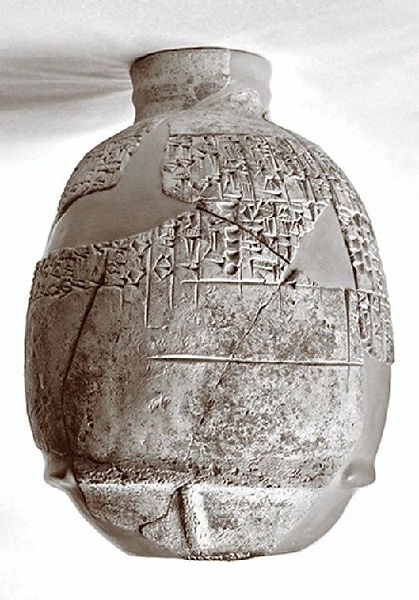
Sumerian Shakespeare
Mace or Vase? in the British Museum

On 7th January 2019, The Art Newspaper posted the following article:
British Museum realises 'vase' is in fact an ancient mace-head displayed upside down
Curators discovered old mistake during research for No Man's Land exhibition
NANCY KENNEY
Inspired by some contemporary photographs shot in southern Iraq, the
British Museum has mounted No Man’s Land (until 27 January), a small
exhibition attesting to man’s chronic inability to exist peacefully
within agreed borders. The exhibition showcases three ancient objects
that tell the story of the first recorded border conflict, a clash
between two Sumerian city states in the third millennium BC, while
juxtaposing them with the modern photographs. Inscriptions on two of
the objects document the viewpoints of the ancient city states of
Lagash and Umma, with each side invoking claims to disputed territory
supposedly allotted them by the gods.
In a bit of serendipity, the curators realised during research for the
show that an object they had long assumed was a vase had actually been
displayed upside down. They now understand that it is actually the
head of a fired-clay mace, or heavy club, made for King Gishakidu of
Umma. After comparing the object with a similar one at Yale
University, “we realised how daft we’d been”, says Irving Finkel, a
co-curator of the show. Now displayed right-side up, the mace head is
topped by a painted representation of a net that was used to
immobilise enemies for execution.
==========================
Actually, it really is a vase, not a mace-head, and it is pictured upside down.
Not only that, it is also printed in photographic reverse.
It should look like this:

We know this is the proper orientation for the artifact because the writing aligns correctly.

On a regular cuneiform tablet, the signs are written in rows that read from left to right
(like English). Notice that the “pointy” signs face to the right, in the direction they are read.
If this same writing appeared on a royal artifact, like the vase of King Gishakidu, it would
look like this:

On royal/monumental writing, the signs are written by column, reading from right to left.
The pointed signs face downward in the direction they are read.

When properly aligned, this pointed sign faces downward. Also notice that the
column dividers naturally taper off at the ends, in the direction they were drawn.

Lugalzagesi of Umma was a successor to King Gishakidu.
See a brief biography of Lugalzagesi on this website. Also read about Urukagina of Lagash, his opponent in the conflict mentioned above.
A complete description of the Sumerian "Hundred Years War" is given on the page about
War: Umma and Lagash.
February 5, 2019
